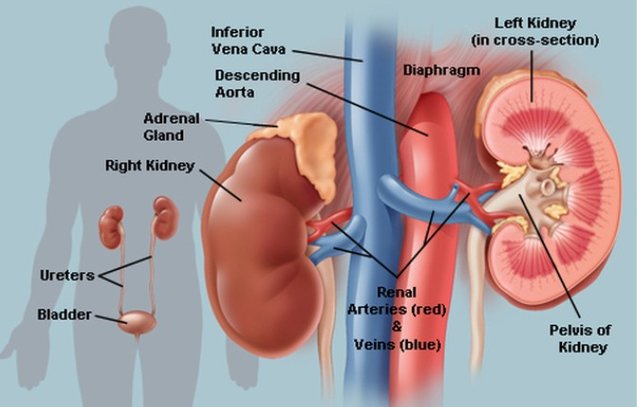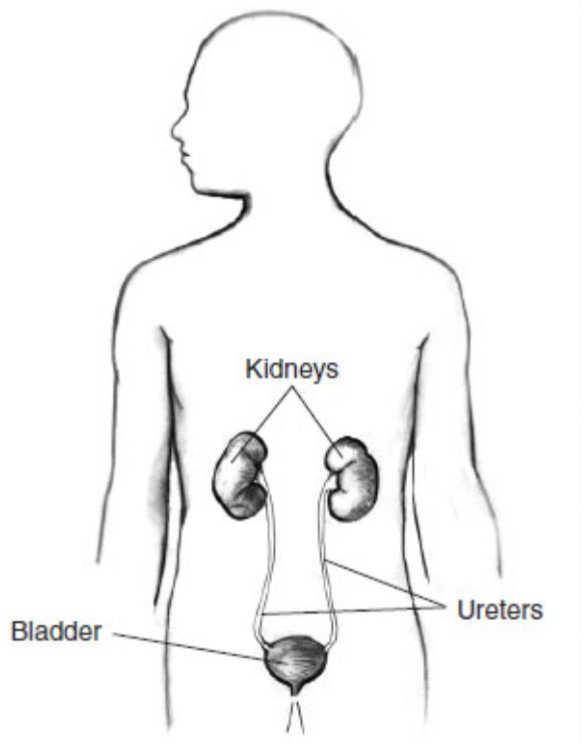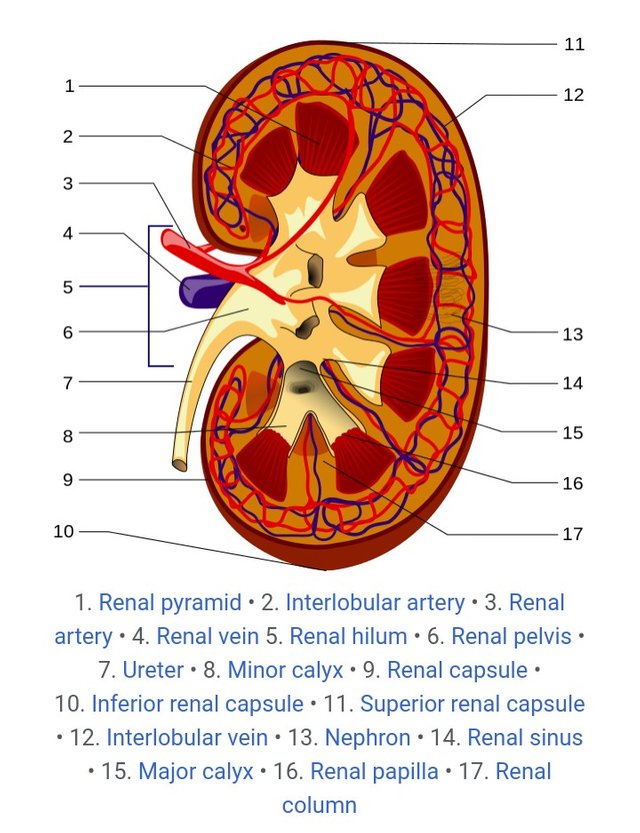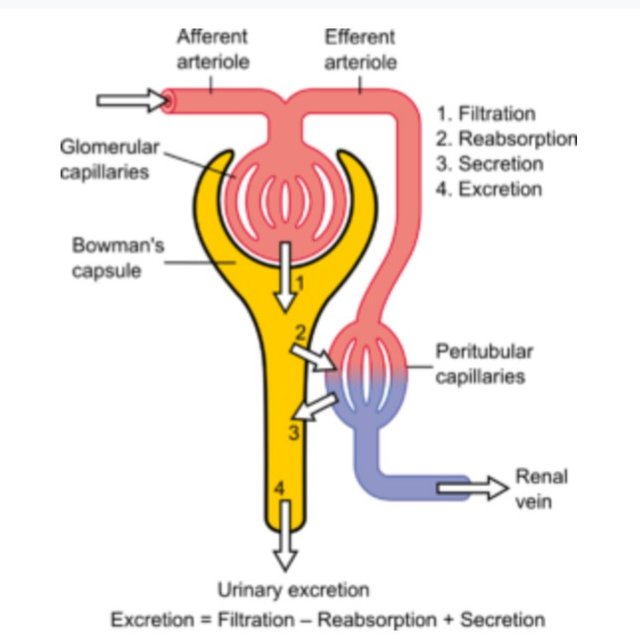SCIENCE OF THE KIDNEY AND TIPS TO HELP KEEP THE KIDNEY IN A GOOD AND PERFECT CONDITION.
Diabetes, High blood pressure, or even the history of kidney failure puts one in three individuals at an increased risk of developing kidney disease, so to be on a safe side, it’s important to take care of this critically important organ.
The kidneys are a pair of bean-shaped organs situated on either sides of the spine, below the ribs and behind the belly, in the renal system. The kidneys receive blood from the paired renal arteries and then blood exits into the paired renal veins. Both kidneys are linked to a ureter a (tube that carries excreted waste (urine) to the bladder). The kidney helps in fluid osmolality, acid-base balance, various electrolyte concentrations, and removal of toxins. An adult kidney contains about one million nephrons (NOTE: The nephron is a tiny filter situated in the kidney, it is the basic structural and functional unit of the kidney, which filters the blood in order to regulate chemical concentrations, and thereby produces urine).
Filtration, reabsorption, secretion, and excretion are the four processes utilized by the nephron to alter the blood plasma which flows to the kidney.
The kidney also helps in creating hormones that help produce red blood cells, regulate blood pressure and promote bone health. The kidneys filters about 120 to 150 quarts of blood to produce about 1 to 2 quarts of urine composed of wastes and extra fluid.
The kidneys help the body pass waste (urine), the kidney also helps filter blood before sending it back to the heart.
THE STRUCTURE OF THE KIDNEY.
The upper part of the kidney is protected by the 11th and 12th ribs and also the kidney is surrounded by tough fibrous tissue, the renal capsule, which is itself surrounded by perirenal fat, renal fascia, and pararenal fat. The anterior (front) surface of these tissues is the peritoneum, while the posterior (rear) surface is the transversalis fascia. The weight of the kidney in matured males ranges 125 to 170 grams, while in matured female its between 115 grams to 155 grams.
Waste products (which are turned to urine) flows from the kidneys into the bladder through two thin tubes of muscle (ureters), one on each side of the bladder.
The bladder stores the urine until it gets full, then sends signals to the brain, which tells a person to find a toilet soon.
The nephron which includes a filter (glomerulus) and a tubule, work through a two-step process. After blood passes to the nephron, it then goes to the renal corpuscle, also known as Malpighian body. The renal corpuscle contains two additional structures, namely glomerulus and bowman capsule (NOTE: The remaining fluid, called capsular urine, passes through the Bowman capsule into the renal tubules).
The glomerulus allows fluid and waste products pass through it, therefore, preventing blood cells and large molecules, mostly proteins, from passing. The filtered fluid is then passed through the tubule, which sends needed minerals back to the bloodstream and takes out wastes. After which the end product becomes urine.
(NOTE : The renal tubules are a series of tubes that begin after the Bowman capsule and end at collecting ducts).
FUNCTION OF THE KIDNEY
The kidneys function includes the whole-body homeostasis, regulating acid-base balance, electrolyte concentrations, extracellular fluid volume, and blood pressure.
HOMEOSTASIS
The kidney is able to perform these homeostatic functions both independently and with the aid of other organs, especially those of the endocrine system. Various endocrine hormones coordinate these endocrine functions, and these include renin, angiotensin II, aldosterone, antidiuretic hormone, and atrial natriuretic peptide, among others.
The kidneys excrete a variety of waste products produced by metabolism into the urine, which include the nitrogenous wastes urea, from protein catabolism, and uric acid, from nucleic acid metabolism. The capability of mammals and some birds to concentrate wastes into a volume of urine much smaller than the volume of blood from which the wastes were extracted is dependent on an elaborate countercurrent multiplication mechanism. This requires several independent nephron characteristics to operate, a tight hairpin configuration of the tubules, water and ion permeability in the descending limb of the loop, water impermeability in the ascending loop, and active ion transport out of most of the ascending limb. In addition, passive countercurrent exchange by the vessels carrying the blood supply to the nephron is essential for enabling this purpose.
ACID -BASE BALANCE
Maintenance of pH around a relatively stable value (maintenance of acid-base homeostasis) is a function of two organ systems, namely; the kidney and the lungs.
The lungs aids in acid-base homeostasis by the regulation of carbon dioxide (CO2) concentration. While the kidneys reabsorbs and regenerate bicarbonate from urine, and to excrete hydrogen ions and fixed acids (anions of acids) into urine.
REGULATION OF OSMOLALITY
This is the maintenance of water and salt level of the body. Any innegligible rise in plasma osmolality is detected by the hypothalamus (the region of the forebrain located below the thalamus, forming the basal portion of the diencephalon, and functioning to regulate body temperature, some metabolic processes and governing the autonomic nervous system), which communicates directly with the posterior pituitary gland. An increase in osmolality causes the gland to secrete antidiuretic hormone (ADH), resulting in water reabsorption by the kidney and rise in urine concentration. The two factors work hand in hand to ensure the return of plasma osmolality to its normal levels.
KIDNEY INJURY AND KIDNEY FAILURE
Generally, humans can live normally with just one kidney, as one has more functioning renal tissue than is needed to survive. Only when the amount of functioning kidney tissue is greatly diminished does one develop chronic kidney disease. Renal replacement therapy, in the form of dialysis or kidney transplantation, is indicated when the glomerular filtration rate has fallen very low or if the renal dysfunction leads to severe symptoms.
DIALYSIS
This is a treatment that over takes activities that healthy kidneys do normally. Dialysis is needed by the Kidneys when approximately 85% to 90% of the kidney function is lost, in addition to a Glomerular Filtration Rate (GFR) of less than 15. Dialysis maintains homeostasis by removing excessive water and other salts, therefore regulating blood pressure, and maintaining chemical levels within the body. Dialysis is a treatment that does not cure kidney disease, a kidney transplant will cure kidney disease. While a costly procedure, Dialysis has a life expectancy of 5–10 years with patients who lived up to 30 years while receiving treatment. However, patients receiving the dialysis treatments are still able to live normal lives, although they may go for check ups from time to time.
KIDNEY CONDITIONS
PYELONEPHRITIS (infection of kidney pelvis): Bacteria may infect the kidney, and as result, causes back pain and fever. Untreated bladder infection caused by bacteria is the most common cause of pyelonephritis. Kidney infections caused by bacteria are treated with antibiotics. Often, cultures of the blood or urine can help guide the choice of antibiotic therapy.
GLOMERULONEPHRITIS: In this case, an overactive immune system may attack the kidney, causing inflammation and some damage. Blood and protein in the urine are common problems that occur with glomerulonephritis. It can also result in kidney failure.
KIDNEY STONES (nephrolithiasis): Minerals in urine form crystals (stones), which may grow large enough to block urine flow. It's considered one of the most painful conditions. Most kidney stones pass on their own, but some are too large and need to be treated (Lithotripsy treatment). Most often, lithotripsy is done by a machine that projects ultrasound shock waves through the body.
NEPHROTIC SYNDROME: Damages to the kidneys makes them to spill large quantity of protein into the urine. Leg swelling (edema) may be a symptom.
POLYCYSTIC KIDNEY DISEASE: This is a genetic condition that results in large cysts in both kidneys that hinder their work.
ACUTE RENAL FAILURE (kidney failure): A sudden worsening of kidneys function therefore, causing dysfunction in kidney. Dehydration, a blockage in the urinary tract, or kidney damage can cause acute renal failure, which may be reversible.
CHRONIC RENAL FAILURE: A permanent kidney dysfunction ( loss of how well the kidneys work). Diabetes and high blood pressure are the most common causes.
END STAGE RENAL DISEASE (ESRD): Complete loss of kidney strength, this occurs as a result of progressive chronic kidney disease. People with ESRD require regular dialysis/ Hemodialysis( a dialysis machine, which filters the blood and returns it to the body. Hemodialysis is typically done 3 days per week) in order to survive or kidney transplant. Transplanting a kidney into a person with ESRD can restore kidney function. A kidney may be transplanted from a living donor, or from a recently deceased organ donor.
PAPILLARY NECROSIS: A very Severe damage caused to the kidneys can lead to chunks of kidney tissues breakage internally and clog the kidneys. If condition remains untreated, the resulting damage can lead to total kidney failure.
DIABETIC NEPHROPATHY: Due to high blood sugar from diabetes, progressively causes damages to the kidneys, eventually causing chronic kidney disease. Could also result to protein in the urine (nephrotic syndrome).
HYPERTENSIVE NEPHROPATHY: This is a kidney damage caused by high blood pressure. Which could later result to chronic renal failure.
KIDNEY CANCER: The most common cancer affecting the kidney is the Renal cell carcinoma. Smoking is the most common cause of kidney cancer.
INTERSTITIAL NEPHRITIS: This is an Inflammation of the connective tissue inside the kidney, often causing acute renal failure. It occurs mostly due to allergic reactions and drug side effects .
MINIMAL CHANGE DISEASE: This is a form of nephrotic syndrome in which kidney cells look like its almost normal under the microscope. The disease can cause significant leg swelling (edema). Steroids are used to treat minimal change disease.
NEPHROGENIC DIABETES INSIPIDUS: In this case, the kidneys lose the ability to concentrate the urine and this is usually caused by a drug reaction, Although it's rarely dangerous. diabetes insipidus causes constant thirst/ dehydration and frequent urination.
RENAL CYST: A hollowed out space in the kidney. Isolated kidney cysts often happen as people age, and they almost never cause a problem. Although Complex cysts and masses can be cancerous.
KEEPING THE KIDNEY HEALTHY
there are a number of things one can do to keep ones kidneys functioning properly and healthy as possible at every stage of life.
The first thing one can do to keep ones kidneys safe is to take care of ones body to reduce chances of developing diseases that put a strain on ones kidneys.
Keep the body Hydrated ; it’s always a good idea to drink enough water, so as to avoid dehydration.
Eat healthy foods; although the kidneys can tolerate a wide range of dietary habits, we must note that most kidney problems arise from other medical conditions, and at that its advised to follow a healthy/ moderate eating habits to control blood pressure. Preventing diabetes and high blood pressure will help keep kidneys stay in good condition.
Exercise regularly; If one is healthy, exercising the body is a good idea because, like healthy eating habits, regular physical activity can help control weight gain and high blood pressure.
Smoking can damage blood vessels, which decreases the flow of blood in the kidneys.
When the kidneys don’t have adequate blood flow, they can’t function at optimal levels. Smoking also increases the risk of high blood pressure as well as the risk of kidney cancer.
Lastly, when one is diagnosed of either diabetes or high blood pressure, the physicians should also screen for kidney dysfunction as part of routine care for those conditions.
References :
Thanks for your time and God bless you.




Great post @ericdavidson...
Thank you @rajivv203